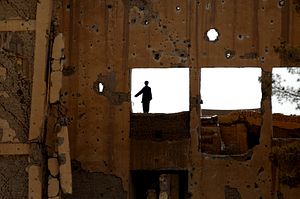The October 3 strike by U.S. forces on a Medecins San Frontieres (MSF, or Doctors Without Borders) hospital in Kunduz resulted in the deaths of more than 30 doctors and patients. It was a shocking attack on a hospital declared to all sides in the conflict and considered under the Geneva Convention not to be a legitimate target. MSF has called the strike a war crime.
The results of a U.S. investigation into the incident point to tragic human error compounded by procedural failures. According to military officials who spoke to the New York Times ahead of the release of the investigation’s report, the crew of the AC-130 gunship that struck the hospital targeted the wrong building:
The military officials, who spoke on the condition of anonymity to discuss the report before its official release, said the investigation found that the gunship’s crew had been unable to rely on instruments to find the target. Instead, they relied on descriptions of the location relayed by troops on the ground, a mix of American and Afghan Special Forces. Based on those descriptions, the crew locked onto the hospital compound, mistakenly believing that it was the building the ground troops were describing, the two officials said.
General John Campbell, commander of U.S. forces in Afghanistan, said at a press conference Wednesday that the strike was the “direct result of human error compounded by process and equipment error.”
According the Associated Press, which received an early copy of the report, the intended target was a National Directorate of Security (NDS) compound 450 meters from the hospital. The compound had been taken by the Taliban and was being used a command and control center. The crew of the gunship, however, “was unable to identify the objective when the grid reference was programmed into the AC-130’s fire control system.” This led the crew to rely on a physical description of the target. The report notes that maps used by the U.S. Special Force commander on the ground who authorized the strike did not identify the hospital, nor was the facility marked “so as to distinguish it as a protected medical establishment.”
Earlier this month, Christopher Stokes, the general director of MSF said while presenting the group’s own report on the attack that “All the information that we’ve provided so far shows that a mistake is quite hard to understand and believe at this stage.” MSF’s detailed report goes into tragic detail, claiming that hospital staff and patients were fired upon as the fled the building.
Campbell told reporters that some of the individuals involved in the incident have been suspended. As of this writing, MSF has not publicly responded to the findings of the U.S. investigation.
































